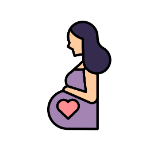
Confinement Wellness
Understanding Traditional Indian Confinement Practices
4 min read | Updated on 23-01-2022 by HappyPreggie
(Image credits to PampersIndia)
Traditional confinement practice is a postpartum period for new mothers that have been followed by the Indian culture for many years. It is the time where the women undergo a long resting period to recover their body after childbirth. This practice usually goes on for roughly around 40 days or 6 weeks dedicated for the mothers to recuperate, heal and replenish. Most Indian women, they would choose to return to their mothers’ house for extra support and knowledge regarding motherhood during this time. This is to ensure that the new mothers are doing well and not exerting themselves with any type of strenuous activities. Basically, it is a period where they will be pampered with care as they experience a lot of new different things.
#1 Baby Emphasis
(Image taken from Makchic.com)
Right after delivery, the newborn will be whispered in the name of the Hindu god. At 16 days old, a special prayer is done for the newborn at home and at 30 days old, the newborn will be taken to the temple for prayer to be recited for him or her. The newborn is also given a massage with oil being applied to the entire body on a daily basis. It is done for the baby's bone strength and overall development.
#2 Midwifery Practice
(Image credits to Dailymail)
Traditional Indian postnatal practices are to help the mother revitalise her body by making it warm again. This is due to the fact that blood lost during labour had caused the body to go into a cold stage. The confinement period is 30 days whereby many special practices are followed. Families can hire a special assistant or maid to look after the mother and the baby. Otherwise, an elderly member of the family, commonly called ‘patti’ or ‘ayaah’, would come to help.
#3 Herbal Bath
(Image credits to TheSpruce)
While the Chinese confinement practices strongly prevent the new mother from taking baths, the Indian mothers are allowed to bathe baths but only with warm water that has been boiled with herbs such as neem (Azadirachta indica), mengkudu (Morinda citrifolia) and lemuni (Vitex Trifolia var Negundo) leaves. However, washing the hair daily is not allowed in order to prevent colds. That is why hair washing is done on odd number days such as days 3, 5, 7 until the 1-month confinement is over. It is important to take note that the hair needs to be dried quickly since leaving it wet can cause postpartum depression. Body scrub made from herbs and turmeric, especially turmeric is allowed to be used.
#4 Warming Massages
(Image credits to Masterfile)
The Indians use specific oils like sesame oil to control stress and blood pressure besides the cooling properties it possesses. Moreover, they have coconut oil that is usually used for head massages to give a cooling and hydrating effect on the body. Applying it on the pregnant belly reduces the appearance of stretch marks because it is a natural moisturizer. Finally, they use olive oil for enhanced skin and hair. However, in the case of C- section oil massage is done only after the stitch is healed.
#5 Food and Nutrition
(Image credits to EveningStandard)
Meals made out of sesame seeds, dry nuts, fenugreek seeds/leaves, garlic, drumsticks and carom seeds are given to mothers to increase breast milk supply. Edible gum cooked with dry nuts and wheat is served to strengthen the back and the reproductive organs. Fresh cow‘s milk is given first thing in the morning to enhance the quality of the new mother‘s milk. Food that is considered ‘cold’ or ‘windy’ should be avoided. Examples of these foods are cucumber, murungai (Moringa oleifera) fruits, eggplant, jack fruit and grapes.
#6 Belly Bind
(Image credits to PrasavaRaksha)
After bathing, the tummy is usually tied with a cotton sari or cloth. The purpose is similar to Malay and Chinese tradition, which is done to push back up the uterus to its normal position. Belly binding also helps to get rid of stomach gas. Some other benefits of belly binding include promoting healthy posture during breastfeeding, gently pushing the stomach muscles back together, repositioning the womb, and reducing stretch marks. For the Malay community, this belly bind is known as ‘barut’.
Other Taboos
(Image credits to Depositphotos)
- Mothers can only bathe at sunrise or mid-morning
- Must keep the body warm all the time
- Avoid fan and air conditioning to stay away from cold winds
- No watching TV and reading to avoid straining the eyes
- No crying, stressing, shouting or engaging in arguments
- Don’t do household chores
- Stay in the room until the end of confinement
- Sleep only after the baby sleeps
The postpartum phase is highly valued by the Indian culture, regardless of the community. When it comes to the confinement practice, different families have different teachings on how to follow the practice’s rules and regulations. Nevertheless, most mothers still do their best to stick with the original tradition as much as they can. In the end, the true concept of the practice still remains the same, which is to help the mother heal and regain her strength after a rigorous labour process.
Want to read more? Check out this information about the Malay and Chinese traditional confinement practices.
Join the largest support network for family health and well-being. Ready to get started?
Get started
















